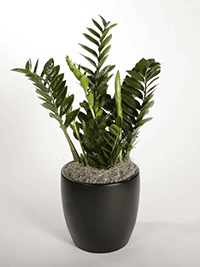
Common Name: ZZ plant
Light Needs
Medium to low light
Water Requirements
Water sparingly
Description:
Small to a table-top height bush. Zamioculcas zamiifolia leaves arise directly from thick horizontal rhizomes. The flower is a green spathe up to two and one-half inches long surrounded by a short white spadix.
Most commonly used varieties: Zamioculcas zamiifolia ‘Raven’ and Zamioculcas ‘Zamicro’
Tabletop to small bush. Leaves arise directly from thick horizontal rhizomes. The flower is a green spathe up to two and one-half inches long surrounded by a short white spadix. The leaves are thick, almost succulent to the touch and dark green. They always look like they have just been leaf shined. The new growth is a striking lime green, almost spiral in effect as it emerges from the amazingly thick bulbous roots.
The Zamioculcas zamiifolia is a close relative of a Spathiphyllum though you might not know that at first glance because they are very different in leaf appearance. It has leaves similar in shape to the Zamia palms, hence its botanical species name (“zamiifolia” which means foliage like the Zamia).
The ZZ is in the Aroid family and is native to South Africa. The great reference manual Hortus Third describes it as a stemless herb, with leaves to three feet long in elliptic pairs of six inches wide. Leaves arise directly from thick horizontal rhizomes. The flower is a green spathe up to 2 ½ inches long surrounded by a short white spadix. I would add to this description that the leaves are thick, almost succulent to the touch and dark green. They always look like they have just been leaf shined. The new growth is a striking lime green; almost spiral in effect as it emerges from the amazingly thick bulbous roots.
Thrives in warm, evenly heated temperatures in medium to low light. Plants will remain alive in low light for a remarkably long period of time if water levels are kept low. In very low light, growth will be slow. Any new leaves will be somewhat smaller than those grown in better light. On the other hand, in very high light the leaves can tend to bleach out or even burn.
Zamioculcas zamiifolias prefer not to have soggy roots and entire stalks will rot off when kept perpetually too wet. Let them dry back between waterings. A big drink followed by a drying out period seems to work best for these plants. Leaf rot is likely when they are overwatered.
These close relatives of a Spathiphyllum, need little pinching, pruning and grooming. All of your plants do need an aesthetic eye for shaping them in an attractive style. Even ZZ’s need a helping hand. Occasionally they get a bit out of control with their new growth, shooting off a new leaf in an odd direction that is outside the regular fountain shape of the plant. It’s OK to cut it off. In fact, it is necessary. Long branches can get out into aisles or get so heavy they lie down and touch the floor. Prune these branches back to the soil level.
ZZ’s have a huge root system that pushes up and out. They start to bust up their grow pots and push up over the tops of the grow pots making watering impossible. Don’t pot into just any kind of SIP. Stage them in a slightly larger than normal decorative pot with a large vinyl saucer to catch overruns. When installing them, plan ahead for future root expansion.
Another great aspect of this plant is the lack of pest infestation. Watch for occasional scale and mealybug.
